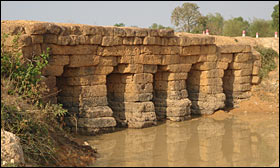Spean Praptos saved by World Bank
The World Bank have helped to protect one of Cambodia's cultural landmarks, Spean Praptos at Komping Kdei, the best surviving example of an Angkorean bridge in the country, as well as another collection of smaller laterite-built bridges between Siem Reap and Kompong Thom. Here's how they reported their success:

The Kampong Kdei Bypass on National Road No. 6
Following a route along an ancient Angkor highway dating from the 12th - 13th Century, National Road No. 6 (NR6) connects Siem Reap and Kompong Thom provinces. Recent rehabilitation activities drew special attention to the need for Cambodia to protect these unique cultural assets from increasing vehicle and heavy traffic. With a view to preserve the authenticity and historical value of the ancient bridges, the APSARA Authority for the Protection ad Management of Angkor and the Region of Siem Reap permitted the Ministry of Public Works and Transport to build 10 bypasses with new bridges around minor ancient bridges and a 1.3 km Kampong Kdei bypass and new bridge to divert traffic off the ancient bridges and onto the new bypasses, in conformity with UNESCO’s ad hoc expert group recommendations of December 2004.
The Kampong Kdei Bridge, one of the dry-jointed laterite block construction engineering wonders along NR6, is located about 45 km southeast of Siem Reap and is the highest and longest of the 800 year old ancient bridges, spanning approximately 85m and 14 m high. Though it was originally agreed by competent authority that the ancient bridge was to be rehabilitated without any bypasses, cultural heritage considerations soon took precedence. Prior to the opening up of newly constructed bypass, this ancient bridge carried all traffic without signs of distress or fatigue. Under the Road Rehabilitation Project, the NR6 civil works contract constituted the rehabilitation of a total of 72 km of road. The contract included replacement of existing bridges and culverts. To comply with modern standards, the road alignment was designed such that appropriate speeds are maintained through each bypass. This required a significant amount of design and drafting of new structures. Outcomes of the NR6 road rehabilitation work resulted in a major upgrading that allows for improved travel between Phnom Penh and the main tourist attraction of the country, Angkor Wat. The road safety improvements - including proper pavement markings, speed breaking humps, rumble strips, guide posts, and signage - were a first for Cambodia, and have set the standard for good road safety practices in the country. Similar safety improvements have been incorporated since to other major road rehabilitation works. No less significant has been the capacity development for managing cultural heritage, resettlement activities, budgeting and implementation in several Government agencies. The 3-year contract started on 7 January, 2002, the construction of the 10 bypasses including the 3 by 20 meter span bridge for the new 1.3 km bypass began the second half of 2005, after settling the safeguards related issues and was officially completed on 31 March, 2006.
For more information about the World Bank program in Cambodia, click here.

One of the smaller laterite-built ancient bridges


0 Comments:
Post a Comment
<< Home